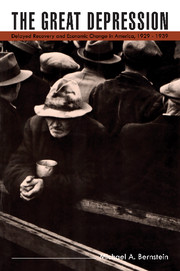Book contents
- Frontmatter
- Contents
- List of tables
- List of figures
- Editors' preface
- Preface
- Introduction: The puzzle of the 1930s
- 1 Long-term economic growth and the problem of recovery in the United States, 1929–39
- 2 The transformation of American industry in the interwar period
- 3 A reassessment of investment failure in the interwar economy
- 4 Technical change during the interwar years
- 5 The effective demand problem of the interwar period. I: Cyclical and structural unemployment
- 6 The effective demand problem of the interwar period. II: Cyclical and secular changes in final demand
- 7 New Deal economic policy and the problem of recovery
- 8 Contemporary economic problems in historical perspective
- Bibliography
- Index
Editors' preface
Published online by Cambridge University Press: 06 July 2010
- Frontmatter
- Contents
- List of tables
- List of figures
- Editors' preface
- Preface
- Introduction: The puzzle of the 1930s
- 1 Long-term economic growth and the problem of recovery in the United States, 1929–39
- 2 The transformation of American industry in the interwar period
- 3 A reassessment of investment failure in the interwar economy
- 4 Technical change during the interwar years
- 5 The effective demand problem of the interwar period. I: Cyclical and structural unemployment
- 6 The effective demand problem of the interwar period. II: Cyclical and secular changes in final demand
- 7 New Deal economic policy and the problem of recovery
- 8 Contemporary economic problems in historical perspective
- Bibliography
- Index
Summary
In the two decades immediately following World War II, the Great Depression of the 1930s was commonly viewed as a business cycle depression, explicable in terms of standard macroeconomic theory. It had been unusually long and deep for a variety of reasons, the emphases among them differing from one analyst to the next. Monetarists stressed blunders on the part of Federal Reserve authorities; Keynesians stressed the late and inadequately passionate embrace of Keynesian fiscal policy by the federal administration. Students of the international scene looked to the concurrent depressions in the United States and Europe, to competitive devaluation and beggar-thy-neighbor tariff policies. Institutionalists spoke of the utter collapse of American financial institutions. Few doubted, however, that the Great Depression had been unique; there would be no recurrence.
This confidence stemmed from the perception that the financial reforms of the New Deal would rule out another debacle of the order of 1929–33 and from the wartime demonstration of the power of federal fiscal policy to cope with unemployment. At the close of the war, Congress had written into law federal responsibility for the maintenance of economic stability, based clearly on Keynesian macroeconomic ideas. The exact devices to be deployed (e.g., public works versus built-in flexibility) and even the relative importance of monetary and fiscal tools might be subject to debate, but there was wide agreement that the strengthened financial system and the new fiscal and monetary tools would ward off another Great Depression.
- Type
- Chapter
- Information
- The Great DepressionDelayed Recovery and Economic Change in America, 1929–1939, pp. xiii - xivPublisher: Cambridge University PressPrint publication year: 1987

